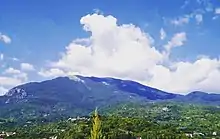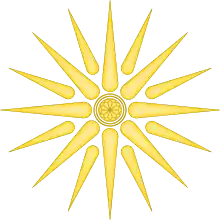Naousa, Imathia
Naousa (Greek: Νάουσα, historically Νάουσσα - Naoussa; Aromanian: Naustã), officially The Heroic City of Naousa is a city in the Imathia regional unit of Central Macedonia, Greece with a population of 21,139 (2016). It is located at the foot of the Vermio Mountains. According to the 2011 census its population was 20,176 inhabitants. The wider municipality, after the administrative reform of the Kallikratis plan, had a population of 32,470 inhabitants. Since 1955, by royal decree, it has been designated as a heroic city for the struggle and sacrifices of the inhabitants in 1822, during the Greek War of Independence.

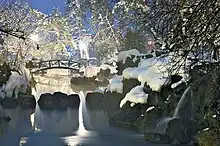
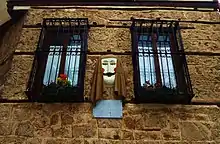
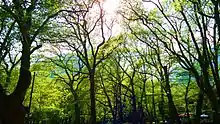
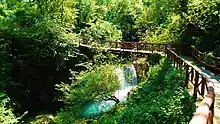
Naousa
Νάουσα | |
|---|---|
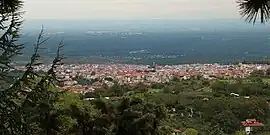 Naousa | |
 Seal | |
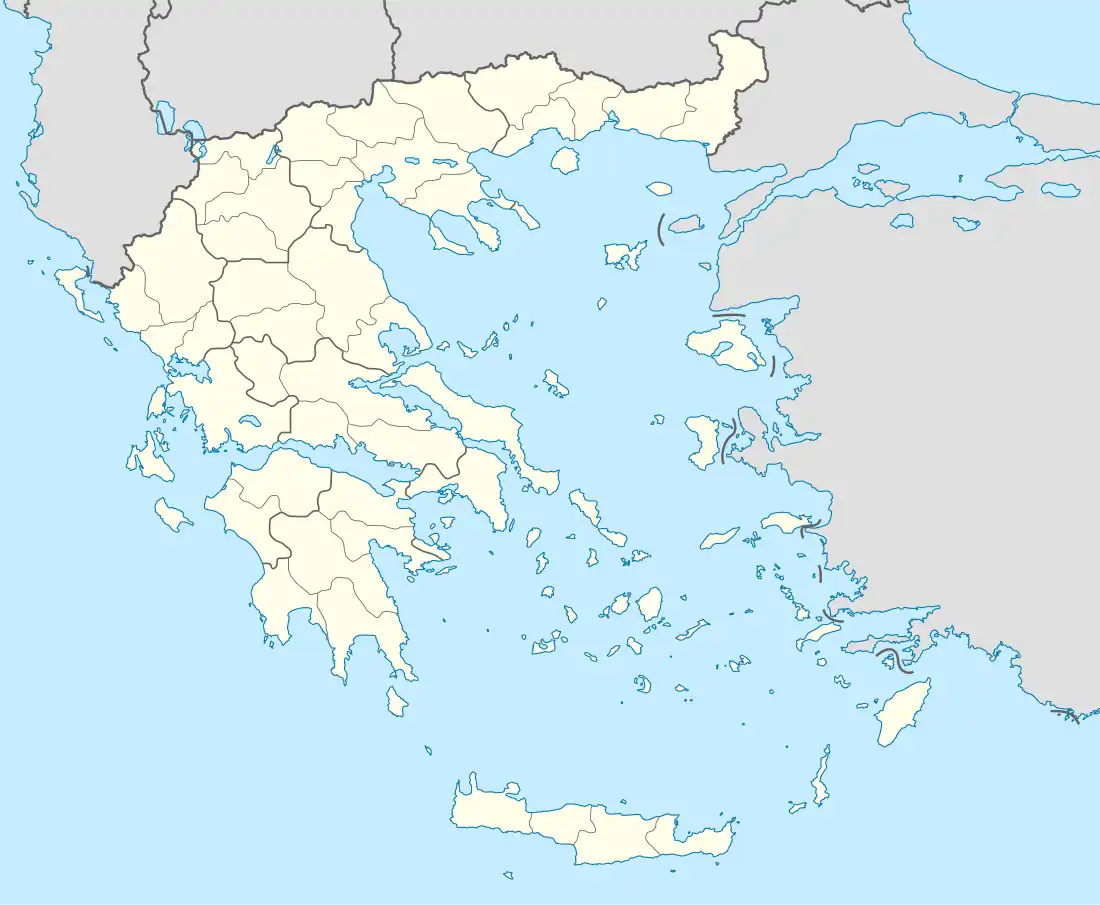 Naousa Location within the region 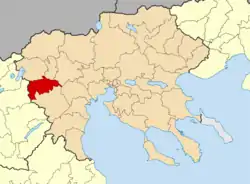 | |
| Coordinates: 40°38′N 22°4′E | |
| Country | Greece |
| Administrative region | Central Macedonia |
| Regional unit | Imathia |
| Area | |
| • Municipality | 425.5 km2 (164.3 sq mi) |
| • Municipal unit | 300.9 km2 (116.2 sq mi) |
| Elevation | 330 - 480 m (−1,240 ft) |
| Population (2011)[1] | |
| • Municipality | 21,152 |
| • Municipality density | 50/km2 (130/sq mi) |
| • Municipal unit | 19,268 |
| • Municipal unit density | 64/km2 (170/sq mi) |
| Time zone | UTC+2 (EET) |
| • Summer (DST) | UTC+3 (EEST) |
| Postal code | 592 00 |
| Area code(s) | 23320 |
| Vehicle registration | ΗΜ |
| Website | www.naoussa.gr |
| Year | Population | Change |
| 1920[2] | 8.483 | --- |
| 1928[3] | 10.438 | +23.05% |
| 1940[4] | 12.815 | +22.25% |
| 1951[5] | 12.584 | -01,80% |
| 1961[4] | 15.492 | +23,11% |
| 1971[6] | 17.375 | +12,12% |
| 1981[7] | 19.430 | +11.83% |
| 1991[8] | 19.794 | +01,87% |
| 2001[9] | 20.176 | +01.93% |
| 2011 |
An industrial center since the 19th century, for most of the 20th century the history of Naousa was closely intertwined with that of the Lanaras family, local industrialists who, at the height of their influence, employed almost half of Naousa's population in their textile factories.[10] The Lanaras family built hospitals, social centers etc. while streets of Naousa were named after family members. In the 1990s and 2000s however, most of the local factories closed, leaving Naousa with a serious (and still unresolved) unemployment problem.[10]
The Arapitsa of Naoussa is one of the few rivers in Greece that has a feminine name; the river that has gone down in history for the great sacrifice of the city's women in April 1822, who preferred that they and their children fall into its water rather than into the hands of the Turks. At the site of the women's sacrifice, in the Stoubanoi area next to the Arapitsa river, there is a monument.
Etymology
Naousa was formerly also known as Niausta. A more likely possibility is its establishment as "Nea Augusta" by the Romans, with "Niausta" and finally "Naousa" being a corruption of it[10]. Another folk etymology considers the name "Naousa" to be a transformation of the verb "nao", i.e. to flow or float (hence also nautical), to a noun. In the Middle Ages, when the city was under the rule of Serbian rulers, it had the name Njeguš(Serb. Његуш, Njeguš).
Municipality
The municipality Naousa was formed at the 2011 local government reform by the merger of the following 3 former municipalities, that became municipal units:[11]
- Anthemia
- Eirinoupoli
- Naousa
The municipality has an area of 425.491 km2, the municipal unit 300.891 km2.[12]
History
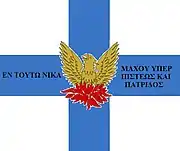
No ancient settlement has been identified in the current location where Naoussa is built. From the ancient history of the area it is stated that its inhabitants were Bryges, a Thracian tribe better known in history as Phrygians, who settled all over Imathia around the 12th century BC. The area, according to Herodotus, was where the fertile Gardens of King Midas were situated. Bryges would later be expelled from the area by Macedonian tribes and settle in Chalkidiki. Residential facilities dating back to the Bronze Age have been investigated in recent decades in the wider lowland area. Later findings from the Archaic era to the Hellenistic period have been excavated at the sites of Kopanos, Hariessa, and Lefkadia, which lead to the conclusion of the existence of an important city, and perhaps the town of Mieza or Meza mentioned in a Delphi dedication, with the site of ancient School of Aristotle. In 168 BC, after the Battle of Pydna, the area fell into the hands of the Romans, who later in the current position of the city established the colony of Nova Augusta. The name changed through the centuries to Niagusta, Niaousta and Niaousa, until it became today's Naousa. It was known as "Ağustos" during Ottoman rule.[14]
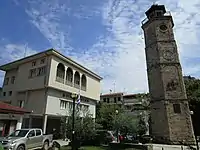
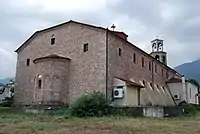
In Naoussa a significant time gap was observed regarding the settlement of the region with an organized form of state. In the late Roman period and the years that followed the ancient settlements began to decline. The resettlement, according to local tradition as well as indirect historical evidence, is placed in the 14th century (1385-86), shortly after the occupation of Veria by the Turks (around 1383-87). At that time anarchy prevailed in the region as disorderly units of ghazis made frequent raids and occupied, often for a short time, Macedonian cities and regions. Frightened residents of the area took refuge, among other places, in the borders of the present-day city of Naoussa, in its forests and mountain refuges and contributed to the repopulation of the area. The local prefect Siah Lianis granted important privileges to its Christian inhabitants. [15]The location where the city is built today was ideal, as the entire plain lay at the feet of the inhabitants who could easily see impending dangers.
After the complete conquest of Macedonia by the Ottomans, the region fell into the hands of Gazi Ahmed Evrenos, one of the most active generals of Sultan Murad I, to whom turkish tradition attributes the capture of almost every important city in Macedonia. Here he established a waqf which his descendants preserved in Giannitsa. The Greek population in the region enjoyed important privileges from the beginning, thanks to the intervention of Valide Hanum Sultana (Mara Brankovic, daughter of the Serbian ruler Đurađ Branković and wife of Murad II). Naoussa was a Christian city from the beginning (apart from the Qadi (judge) and the Voivode (commander) there were no other Ottomans in the city), with self-government rights, its own garrison and important tax privileges, which allowed the rapid concentration of population and the development of handicrafts (weaponry, goldsmithing, weaving, etc.). As early as the 17th century there was an urban center with about a thousand houses and economic influence in the region of central Macedonia and beyond (due to its position on the caravan route that connected the southern Balkan markets). Evliya Çelebi mentions that it was mainly inhabited by Greeks during his visit in the 17th century.[16]
Until the beginning of the 18th century little is known about the city. The first important information refers to an uprising in 1705 when a Turkish official went to the area with the order to recruit young men for the janissary battalions. The residents refused to hand over their children and killed the official and two of his companions. Led by the armatole Zisis Karademos and his two sons, about 100 people raised the flag of rebellion and inflicted blows on the conquerors. However a detachment of 800 Turks managed to surround the rebels and finally kill Karadimos in battle. His two sons were arrested and sentenced to death. The uprising of the Naoussaians in 1705 was one of the most important of the subjugated Hellenism and the reason to stop devshirme in the Greek area.
In 1772 Naoussa was one of the centers of a conspiratorial movement for a rebellion, instigated by Sotirios Lefkadios, an agent of Russia. The bishops of Edessa, Berea, Campania, Platamonos, Servia and Kozani, Petra Olympos and others met in Naoussa and Kozani and they decided to form military corps with the help of the armatoles. The fate of the conspiracy is not known, but at that time (after 1770) the Turks, fearing an attack by the Russian fleet, committed many atrocities against the Greeks. This situation ended with the Treaty of Küçük Kaynarca (1774) by which the Turks were forced to grant many privileges to the Greeks.[17]
At the beginning of the 18th century it was famous the work of the Naoussaian scholar and theologian Anastasios Michail.
Despite this parenthesis Naoussa continued to develop at a rapid pace. In a century the population almost doubled and it gained a reputation for both its wines and its educational activities. It thus attracted the interest of the ambitious Ali Pasha of Ioannina who, with sieges and treachery, tried to annex it between 1795 and 1804. In 1804 the armatole Vassilios Romfeis with his deputy Anastasios Karatasos, after a five-month struggle, were forced to abandon the city, which was occupied by Ali Pasha until 1812 when he abandoned it by order of the sultan.
But the calm lasted only a few years. In February 1822 Naoussa, despite its prosperity, took part in the Greek War of Independence. On that day a solemn declaration of the Revolution was made in the Cathedral of the town with praise, swearing, revolutionary chants and the raising of the flags on the towers and gates of the city.[23] Military operations led by Zafeirakis Theodosiou and Anastasios Karatasos, with the aim of creating a free revolutionary regime in the region, led to the siege of the city by the troops of the Governor of Thessaloniki Mehmet Emin Pasha, known as Ebu Lubut (the batter). Abdul Abud, the Pasha of Thessaloniki, arrived on 14 March at the head of a 16,000 strong force and 12 cannons. The Greeks defended Naousa with a force of 4,000 under Anastasios Karatasos, Dimitrios Karatasos, Aggelis Gatsos, Karamitsos and Philippos, the son of Zafeirakis Theodosiou, under the overall command of Zafeirakis Theodosiou and Anastasios Karatasos. The Turks attempted to take the town of Naousa on 16 March, and again on 18 and 19 March, without success. On 24 March the Turks began a bombardment of the city walls that lasted for several days. After requests for the town's surrender were dismissed by the Greeks, the Turks charged the Gate of St George on Good Friday, 31 March. The Turkish attack failed but on 6 April, after receiving fresh reinforcements of some 3,000 men, the Turkish army finally overcame the Greek resistance and entered the city. The destruction of the city, looting, massacres and persecutions of the population followed. Several women preferred to kill themselves by falling with their children into the foamy waters of the Arapitsa waterfall in "Stubanos" in order not to fall into the hands of the Turks. According to official Ottoman documents 409 Naoussians were killed, 33 left the city and 198 were pardoned, all mostly men. Over 400 women and children were sold as slaves. The properties of the dead and fugitives (655 houses) and the church (226 houses) were confiscated. The fall and massacre of Naousa marked the end of the Greek Revolution in Central Macedonia.[18] A notable survivor of the incident was Greek American refugee Gregory Anthony Perdicaris.After this event the city lost its privileges for the next few years. Many Naoussians continued the struggle in the Greek War of Independence in Southern Greece. distinguished Nausian fighters were the centurion Lazaros (Lazos) Georgiou, the officers (Grade VII) Dimitrios Angelopoulos, Konstantinos Karamesinas and Philippos Karamesinas, the defenders of Hydra Konstantinos Yiannis and Nikolaos Toufexis, the fellow competitor of Anastasios Karatasos Georgios Theodosiou, the subordinate officers Constantine Athanasiou and Ioannis Michael and Emmanuel Pipas (born 1800), Anastasios (Tassios) Emmanuel (born 1805), Angelos Ioannou (born 1797), Dimitrios Konstantinou (born 1801) and George Costa (born 1804). Naoussa was represented by proxy Vaios Georgiou in the Fourth National Assembly at Argos in 1829 and in the 4th repeated National Assembly at Megara in 1831.
Only in 1849 a form of self-government and relative autonomy was allowed again with the election of a ruler. From 1868 the lords were allowed to become mayors of the city, a title that was for the next years continuously in Christian hands. The mayor could officially decide on the commons and had armed bodyguards.
.JPG.webp)
Despite the devastation Naoussa recovered quickly. The 198 Naussians who were pardoned belonged to the wealthiest families. In addition to the fields they also had 43 workshops and 4 large spinning mills. They were the basis for economic development, especially in the manufacture of wool. Christian families moved to Naoussa, while the authorities also favoured the settlement of Muslim families to avoid new excursions. 70 Muslim families responded to the call.
In the last years of Ottoman rule Naoussa experienced commercial and industrial prosperity. The development started mainly with the reforms in the Ottoman Empire. During the Tanzimat period, among other, religious minorities gained equal rights with Muslims and equality provided more certainty in matters of property. Around 20 families formed the basis of economic prosperity for years to come. Through marriages many of them also shared in other families' businesses. In 1874-1875 the "Loggou-Kirtsi-Turpalis" textile factory was founded in Naoussa, probably the first industry in the Balkans in the modern sense of the term. Industrialists have benefited from the international drop in the price of cotton, cheap water as energy and low wages and thus were able to compete satisfactorily cotton imports from abroad. Other industrial textile units followed in the following years and until the beginning of the 20th century. At the same time the Bulgarian woolen producers, who had been strong in the market until then, no longer satisfied the needs of the Ottoman army in terms of quality and thus gradually lost the market of the Empire. The new factories of Naoussa took advantage of the opportunity and the Hatzilazarou factory in particular was unable to satisfy the army's increased demand for woollens.
During the Macedonian Struggle (1904-1908) Naoussa was an important center against the action of the Bulgarian komitadjis. Greek rebel bodies were supported by the city with most important chieftains Epaminondas Garnetas and Ioannis Simanikas. The Macedonian Struggle was the starting point of the victorious liberation wars of the period 1912-1913, known in historiography as Balkan Wars. Naoussa was freed from Ottoman rule on October 17, 1912.
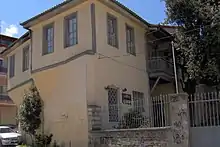
At the time of liberation Naoussa was an industrial city and its population was 9,000 to 12,000 inhabitants, of which around 20% were workers (mostly single women). The city had in 1912 three textile factories with 14,200 looms. Another 3 textile factories with 26,500 looms in Edessa and Thessaloniki were entirely owned by Naousians. Naoussa thus controled at that time 6 of the 10 textile units of Macedonia which in turn had half the production units of the entire Ottoman Empire. 90% of the workers in the mechanized wool processing units were controlled by Naoussians. In the same year the town also had 3 large and dozens of small mills, 3 carpentry plants and dozens of presses, silk mills and smaller wool processing industries.
Economic growth continued unabated even with the city as part of the Greek state. New industrial units were established, agriculture was modernized with systematic tree cultivation and foreign trade took leaps. The city's population experienced a significant increase when large numbers of Anatolia refugees were settled in Naoussa, following the Greco-Turkish War (1919–1922) and the subsequent Treaty of Lausanne.
During the German Occupation Naoussians actively participated in the Greek resistance. The large volume of workers that existed in the city had become a pre-war recruiting ground for KKE. At the same time the mountainous massifs around Naoussa made it possible to organize rebel groups. So (communist) ELAS, which did not tolerate other organizations, established its headquarters and reception centers for recruits in the surrounding mountains. At the same time the civil conflict for the control of the resistance movement begun.
In mid-September 1944 ELAS liberated Naoussa. In May 1945 there were big strikes of the labor movement. In the Civil War that followed the Occupation the city suffered frequent guerrilla attacks. In August 1946 the city was attacked for three days by large groups of rebels. In October of the same year the city was hit again by a force of 400 communists. A large part of Naoussa, which had about 12,000 inhabitants, was burned. At the end of January 1949 the city was occupied by ELAS for two or three days, it was set on fire and many residents, especially young women, were forcibly kidnapped. At the same time most of the prominent citizens were executed including the Mayor of the city. Several of the forcibly recruited will met their death a few days later, as they were thrown naked and on the front line at the Battle of Florina (12.02.49). In June 1949 Naoussa was attacked again and 300 inhabitants became hostages. However the Air Force attacked the retreating rebels who eventually released the abductees.
After the end of the Civil War Naoussa was reborn from its ashes. Destroyed factories were rebuilt, thousands of workers found work again and the burned-out manor center was rebuilt. From the 1950s until today flokates (woolen carpets) have been produced in Naoussa. At the same time in the field of agriculture,new dynamic crops contributed to the further development of the city and the rich forest wealth of Vermio was properly utilized.
Geography
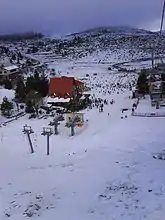

Naousa is located in Northwestern Imathia, 22 kilometers north of Veroia and 90 kilometers west of Thessaloniki, the biggest city in Northern Greece. The city lies on the eastern foothills of Vermio Mountains, one of the biggest mountain ranges in Greece, and west to the plain of Kambania (or Giannitsa). Naousa is today the largest forest-owning municipality in the country[19] being also surrounded by orchards, producing peaches, apples, cherries and other fruits, while the jam brand name Naousa is well-known all over Greece. Naousa is also known for its parks (Municipal Park, Park of Saint Nicholas etc.) and for its ski resorts (3-5 Pigadia and Seli). Due to its location, altitude can raise by as much as 150m between the lowest and highest parts of the city, and it reaches nearly 550m in the Saint Nicholas' Park . Naousa is also home of one of the three female named Greek rivers, Arapitsa, together with Neda in Peloponnese and Erkyna in Livadeia.
Climate
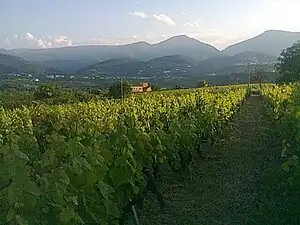
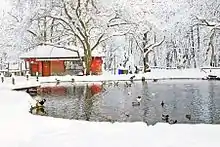
Naousa has a humid subtropical climate (Cfa) in the Köppen climate classification but due to its inland location and elevation, is more continental (and less Mediterranean) than that found in most Greek cities. It is heavily influenced by the mountains which rise rapidly up to the west, and by the plain of Kambania to the east. On one hand, the mountains shelter the area from cold winds blowing from the north and west down the Balkan Peninsula and also from hot southwest winds, creating a non-extreme microclimate. On the other they create föhn winds, which draw in cool, damp air from the Aegean coast. The annual precipitation of Naousa is typically lower than in western Greece, but it is one of the highest in the Macedonia region, measuring around 710 mm per year. Winters can be cold and Vermio mountains are home to two of the most famous skiing resorts in Greece, Seli and 3-5 Pigadia. In the city, snowfall is not uncommon (snow falls at an average of 10–15 days per year) and measurable amounts of snow can remain on the ground for several days. Typically, downtown Naousa experiences milder winter temperatures than the suburbs where temperatures can drop many degrees below zero. Recent years have been a lot warmer and the 2007 European heat wave saw Naousa reaching 40 °C for the first time in recent memory, with an absolute maximum of 41.3 °C in July 25. On January 8, 2017, temperature dropped to -10.5 °C, which is a 10-year low.[20]
| Climate data for Naousa City Hall | |||||||||||||
|---|---|---|---|---|---|---|---|---|---|---|---|---|---|
| Month | Jan | Feb | Mar | Apr | May | Jun | Jul | Aug | Sep | Oct | Nov | Dec | Year |
| Average high °C (°F) | 7.3 (45.1) |
9.1 (48.4) |
13.0 (55.4) |
17.9 (64.2) |
22.8 (73.0) |
27.8 (82.0) |
30.4 (86.7) |
29.3 (84.7) |
24.8 (76.6) |
18.8 (65.8) |
12.4 (54.3) |
8.7 (47.7) |
18.6 (65.5) |
| Daily mean °C (°F) | 4.3 (39.7) |
5.5 (41.9) |
9.0 (48.2) |
13.2 (55.8) |
17.8 (64.0) |
22.4 (72.3) |
24.2 (75.6) |
23.5 (74.3) |
20.0 (68.0) |
14.8 (58.6) |
9.5 (49.1) |
5.8 (42.4) |
14.2 (57.6) |
| Average low °C (°F) | 1.7 (35.1) |
2.5 (36.5) |
5.6 (42.1) |
9.3 (48.7) |
13.7 (56.7) |
17.7 (63.9) |
20.2 (68.4) |
19.6 (67.3) |
16.1 (61.0) |
11.7 (53.1) |
7.1 (44.8) |
3.3 (37.9) |
10.7 (51.3) |
| Average precipitation mm (inches) | 44.3 (1.74) |
58.6 (2.31) |
68.1 (2.68) |
52.1 (2.05) |
67.3 (2.65) |
47.4 (1.87) |
36.2 (1.43) |
28.7 (1.13) |
87.3 (3.44) |
80.5 (3.17) |
69.2 (2.72) |
70.0 (2.76) |
709.7 (27.94) |
| Average precipitation days | 9.5 | 8.8 | 11.5 | 8.0 | 11.3 | 7.4 | 4.7 | 4.5 | 8.3 | 10.5 | 9.0 | 10.8 | 104.3 |
| Average relative humidity (%) | 71.1 | 74.8 | 68.3 | 64.4 | 63.3 | 59.1 | 54.8 | 55.4 | 65.0 | 72.6 | 74.4 | 69.1 | 66.1 |
| Source: National Observatory of Athens[21] | |||||||||||||
Economy
The wider area of Naoussa is famous for its wine production. The Naoussa red wine of the same name has received many awards in the country and abroad. It was one of the first wines in Greece to be released and bottled. The name of the special variety of this wine is xinomavro, which is a Designation of Origin of Superior Quality (D.O.P.A.), and with special characteristics and taste that are formed using the "blank de noir" method. The wider plain area of Naoussa produces high quality peaches, apples and cherries and they are available in domestic and international markets.
Architecture
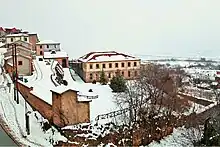
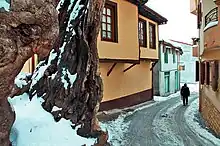
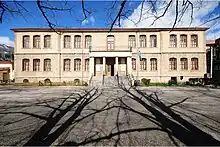
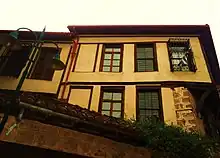
The hallmark of the city is the Clock Tower, commonly known as "Roloi", located in front of the Town Hall. It is a donation of the industrialist Georgios Anastasiou Kirtsis, it was built in 1895 with ashlar and is 25 meters high. It retains its original mechanism. There are thoughts of making it accessible for visitors, allowing views of the city.
A new trademark tends to be the Obelisk that is placed in the central square of the city, it was built in 2000 and completed in 2002. It is 11 meters high. The city has no old churches as they were all burned in the Holocaust of the city by the Turks in 1822. The exception is the small Church of the John the Baptist (Prodromou), which was miraculously saved. The oldest churches (Saint George and Panagia) date from the 19th century and are three-aisled basilicas. Even older churches destroyed in 1822 were replaced by later ones.
The traditional Macedonian-style buildings that exist in Naoussa usually occupy quite a large volume and are two-storey with an inner courtyard. They are made of tufa, adobe and wood. Unfortunately, few of them survive today. They are concentrated in various districts/neighborhoods of the city: While in "Pouliana" and "Batania" there are the largest, urban buildings, in "Alonia" the smaller folk houses dominate. Among the individual buildings worthy of mention are the "Galakeia" and "Sefertzio" schools and the "Lappio" Gymnasium which were named after the names of their donors.
The city is scattered with industrial buildings that were used during the 19th and 20th centuries mainly as extile factories. From the 1990s onwards, the factories gradually ceased to operate, as a result of the global crisis in the textile industry. Thus, empty trunks were left in the city to remind of its rich Industrial past. Already, several of these buildings have fallen to the Municipality, which is beginning to change their use, such as one that houses the Department of Technology Management of the University of Macedonia, while others are being turned into Museums and multi-cultural spaces.
Transport
Naoussa is served by Naousa railway station on the Thessaloniki-Florina railway. Inaugurated in 1894, it connects the city with Thessaloniki and the rest of Northern Greece. Since 2009 it is served by the suburban services to Thessaloniki and Edessa.
Sights and Activities
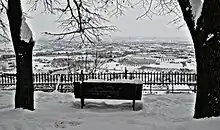
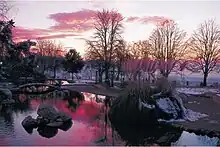
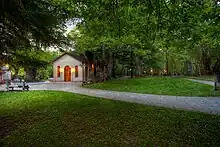

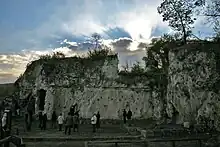
Museums
- Historical and Folklore Museum: It has exhibits of the cultural heritage of Naoussa and the surrounding areas. Among the exhibits are local costumes of the town and the region, textiles, looms, weapons and jewelry. It is located at St. Dimitriou 10.
- Wine and Vine Museum: It is located at 17 Hatzimalousi Street, in the house of Yiannis Boutaris, founder of the company of the same name. It is a traditional neoclassical building from 1908, which was also the first winery of the city. In the museum the visitor can learn about the history and the process of wine production in the area and about all the necessary objects related to wine.
- Vlach Folklore Museum: It has exhibits from the life of Naoussa΄s Vlachs. Among other things one will see looms, flokates and uniforms. It is located at 23 Sofroniou Street.
- Euxinos Pontian Club of Naoussa: Here the visitor will find a large library containing almost 1,000 books from the Library of Argyroupolis in the Black Sea Region which the refugees brought from there in 1923. Originally there were around 5,000, but many were destroyed by the collapse of the building where they were originally housed, others were distributed and others were stolen. An attempt is now being made to save the remaining books by copying them into modern electronic media, studying and preserving them.
- Simanika Collection: This is a private collection of classical music donated to the Municipality. The collection includes many records, CDs, cassettes and videotapes.
Parks
Naoussa is surrounded by a lot of greenery and has several parks. The municipal park, which was created in the 1950s, has an area of approximately 30 acres, is one of the most important inner-city parks in Greece, with a commanding view of the plain of Imathia, the landscaped flower garden and a lake of approximately 1.5 acres that hosts fish, ducks and swans. In 2021 the municipal park officially joined as a full member of the European Route of Historic Gardens of the Council of Europe (ERHG).[22] The most famous grove is that of Agios Nikolaos.
Agios Nikolaos
At a distance of only three kilometers from the center of the city, the sources of the Arapitsa river are located among dense vegetation of plane trees. Arapitsa supplies water to the city and irrigates the fertile estates of the entire region. The local vegetation also includes wild native boxwood, linden and oak trees. The location provides organized sports areas such as volleyball, basketball, tennis, football courts as well as a state-of-the-art indoor swimming pool of Olympic dimensions. There are also guest services facilities with hotels and restaurants.
Ski resorts
At a distance of 17 kilometers from the city, the ski centers of Seli and that of 3-5 Pigadia are located, which are two of the best known ski centers of Central Macedonia. In fact the Seli ski center is the first organized ski center in the country and is located in the village of Kato Vermio, one of the highest villages in Greece.[23] The ski center of 3-5 Pigadia is newer than that of Seli and belongs administratively to the Municipality of the Heroic City of Naoussa.[24] It is a modern ski center at an altitude of 1,430 - 2,005 meters with ski slopes of every difficulty degree and endurance roads. It is the first ski center to have an artificial snow system in Greece.
Archaeological sites
- The School of Aristotle in the Nymphaeum of Mieza (It is located in the "Isvoria" location of Naoussa). It is a landscape rich in water and vegetation where the Nymphaeum, the Sanctuary of the nymphs, is located. The first signs of use of the area go back to the Iron Age, but after the middle of the 4th century BC the site was transformed into a school and here the philosopher Aristotle taught the young Alexander philosophy, ethics, arts and mathematics. Between two natural caves the rock was carved vertically, an ionic colonnade was added and a C-shaped covered gallery was created. In the Archaeological Museum of Veria there are tiles and clay tiles from the roof of the gallery.
- The ancient theater of Miesza of Hellenistic period (2nd century BC). It was discovered by chance in 1992. It had a capacity of around 1,500-2,000 spectators. Excavations continue near the theater where the market of Miesza is located).
- The great Macedonian tomb "of Judgment" (Early 3rd century BC. Monumental two-chambered Macedonian tomb with a two-story facade and four paintings with scenes of the Judgment of the dead in Hades. Probably tomb of Peucestas, general of Alexander the Great, from Miesza).
- The Macedonian tomb of Lyson and Callicles (Around 200 BC. A small two-chambered Macedonian tomb with a simple facade and colorful paintings. It contains the bones and ashes of four generations of a high-ranking military family and was named after two of the dead) .
- The Macedonian tomb of the Anthemians (3rd century BC. Two-chamber vaulted Macedonian tomb).
- The Macedonian Tomb of Kinch (Around 310-290 BC. A small two-chambered Macedonian tomb with a simple facade. The painted decoration of the interior is no longer preserved. It was named after the Danish archaeologist Kinch who excavated it at the end of the 19th century).
Sports
Skiing club EOS Naousas is the oldest of the city's sporting clubs, having been founded in 1932. Naoussa also hosts the clubs Naoussa F.C., which played at First National Division of Greece for one year (season 1993–94) and EGS Zafeirakis Naousas (Greek: Ε.Γ.Σ.Ζαφειράκης Νάουσας) that competes at volleyball, handball and basketball. The name refers to the Greek prokritos Zafeirakis Theodosiou (Greek: Ζαφειράκης Θεοδοσίου) (1772–1822).
| Sport clubs based in Naoussa | |||
|---|---|---|---|
| Club | Founded | Sports | Achievements |
| EOS Naousas | 1932 | Skiing | 185 Greek champions, 13 athletes at Winter Olympic Games |
| Naoussa F.C. | 1962 | Football | Earlier presence in A Ethniki |
| EGS Zafeirakis Naousas | 1974 | Volleyball, Handball, Basketball | Earlier presence in A1 Ethniki Volleyball and Handball |
| Gimnastiki Enosi Naousas | 2007 | Track and field | Athletes at Greek Championships and World Junior Championships |
| Naousa Swim Club | 2015 | Swimming | |
International relations
Twin towns — Sister cities
Naousa, Imathia is twinned with:[25]
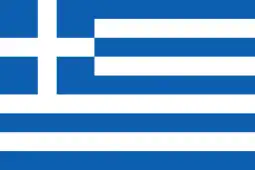 Missolonghi, Greece
Missolonghi, Greece Naousa, Paros, Greece
Naousa, Paros, Greece Faches-Thumesnil, France (1992)
Faches-Thumesnil, France (1992)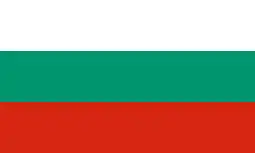 Asenovgrad, Bulgaria (1994)
Asenovgrad, Bulgaria (1994) Zgorzelec, Poland (1998)
Zgorzelec, Poland (1998)
Notable people
- Anastasios Michail (17th century-1722), theologian
- Zisis Karademos (17th century-1705), armatole, led a rebellion
- Anastasios Karatasos (1764–1830), armatole
- Vassilios Romfeis (1773-?), klepht
- Gregory Anthony Perdicaris (1810-1883), first U.S. Consul to Greece, Author
- Zafeirakis Theodosiou (18th century-1822), political leader
- Lappas bros (19th century), merchants and benefactors of the city
- Ioannis Simanikas, (late 19th century-?), chieftain of the Macedonian Struggle.
- Grigorios Longos, textile industrialist
- Eleni Tsaligopoulou (1963-), Greek singer
- Konstantinos Prousalis (1980-), Greek volleyball player
- Sophia Ralli (1988-), Alpine skier, 3-time Olympian, Greece's flag bearer at the 2018 Winter Olympic Games
- Apostolos Giannou (1990-), Greek-Australian footballer
Gallery
 Mattheou mansion
Mattheou mansion Stumbani waterfall in the town
Stumbani waterfall in the town Municipal school
Municipal school Monument to the "Heroines of 1822"
Monument to the "Heroines of 1822" Panoramic view
Panoramic view Agios Nikolaos park
Agios Nikolaos park Traditional dress[26]
Traditional dress[26] View from Theologos hill
View from Theologos hill
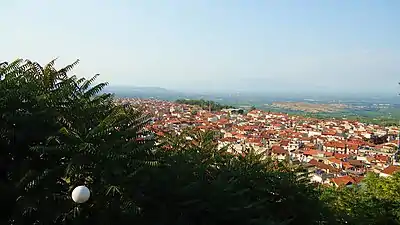 View of the eastern part of the city
View of the eastern part of the city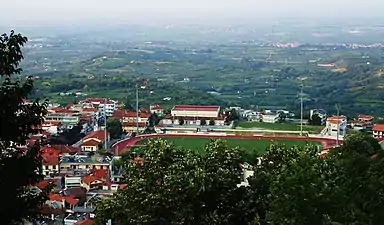 View of the Municipal Stadium Ant.Konstantinidis
View of the Municipal Stadium Ant.Konstantinidis View of the city from the road to Seli
View of the city from the road to Seli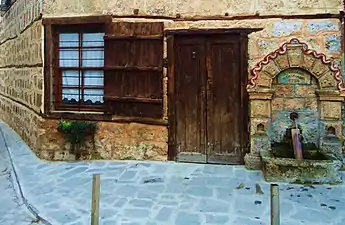 Traditional building and fountain, in the center of the city
Traditional building and fountain, in the center of the city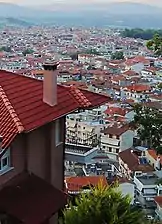 View from the last houses on the road to Seli
View from the last houses on the road to Seli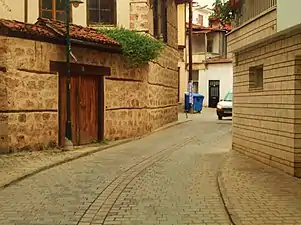 Traditional pedestrian street in an old neighborhood
Traditional pedestrian street in an old neighborhood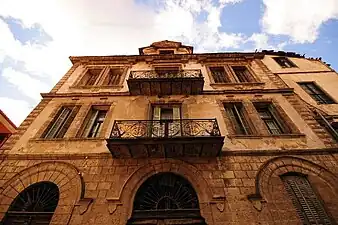 Traditional building in the city center
Traditional building in the city center.jpg.webp) The Place of Sacrifice, where the women of the city fell into the Falls in 1822
The Place of Sacrifice, where the women of the city fell into the Falls in 1822.jpg.webp) The Arapitsa River, as seen from the "Hospital Bridge"
The Arapitsa River, as seen from the "Hospital Bridge" Vineyard that produces the local Xinomavro variety in the area of Naoussa.
Vineyard that produces the local Xinomavro variety in the area of Naoussa.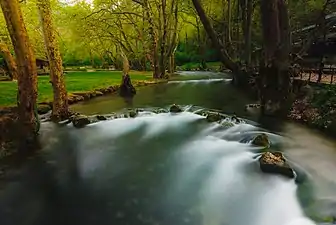 The river Arapitsa at the foot of Vermio
The river Arapitsa at the foot of Vermio
See also
References
- "Απογραφή Πληθυσμού - Κατοικιών 2011. ΜΟΝΙΜΟΣ Πληθυσμός" (in Greek). Hellenic Statistical Authority.
- http://dlib.statistics.gr/Book/GRESYE_02_0101_00016.pdf
- http://dlib.statistics.gr/Book/GRESYE_02_0101_00023.pdf
- http://dlib.statistics.gr/Book/GRESYE_02_0101_00025.pdf
- http://dlib.statistics.gr/Book/GRESYE_02_0101_00031.pdf
- http://dlib.statistics.gr/Book/GRESYE_02_0101_00039.pdf
- http://dlib.statistics.gr/Book/GRESYE_02_0101_00062.pdf.pdf%5B%5D
- http://dlib.statistics.gr/Book/GRESYE_01_0002_00060.pdf.pdf%5B%5D
- http://dlib.statistics.gr/Book/GRESYE_01_0002_00060.pdf
- "Εγκλωβισμένη στα τείχη της κλωστοϋφαντουργίας η κοινωνία της Νάουσας | Η ΚΑΘΗΜΕΡΙΝΗ". 2 October 2004.
- "ΦΕΚ A 87/2010, Kallikratis reform law text" (in Greek). Government Gazette.
- "Population & housing census 2001 (incl. area and average elevation)" (PDF) (in Greek). National Statistical Service of Greece.
- "Detailed census results 1991" (PDF). (39 MB) (in Greek and French)
- "Archived copy" (PDF). Archived from the original (PDF) on 2012-03-24. Retrieved 2017-01-13.
{{cite web}}: CS1 maint: archived copy as title (link) - Κωνσταντίνος Βακαλόπουλος, Ιστορία του βόρειου Ελληνισμού: Μακεδονία,εκδ.Αφοί Κυριακίδη, Θεσσαλονίκη, 1992,σελ. 64
- Η Κεντρική και Δυτική Μακεδονία κατά τον Εβλιγιά Τσελεμπή, μετάφραση και σχόλια: Βασίλειος Δημητριάδης, Έκδοση ΕΜΣ, 1973
- Βασδραβέλλης Ι.Κ., "Οι πολεμικοί άνδρες της Μακεδονίας κατά την προεπαναστατικήν περίοδον", Μακεδονικά, Τόμ. 7 (1967), σ. 48, 49
- John C. Vasdravellis, The Greek Struggle for Independence: The Macedonians in the Revolution of 1821 (1968), p. 123-24, 136
- "Naoussa today". Archived from the original on 2017-08-17. Retrieved 2017-08-17.
- http://www.naousa.gr/files/business-plan-2012-2014-phase-A.pdf
- "National Observatory of Athens". Meteo.gr. Retrieved 2020-11-13.
- «Νάουσα: Στους «ιστορικούς κήπους» της Ευρώπης το δημοτικό πάρκο της πόλης». m.naftemporiki.gr. Ανακτήθηκε στις 20 Μαΐου 2021.
- http://www.veria.gr/
- "Αρχειοθετημένο αντίγραφο". Archived from the original on 2012-03-09. Retrieved 2012-03-15.
- "Twinnings" (PDF). Central Union of Municipalities & Communities of Greece. Archived from the original (PDF) on 2017-06-30. Retrieved 2015-01-05.
- Zaliou-Basiakouli, Eugenia (2014). "Women and costumes of Naoussa, the end of an era". Macedonian Studies Journal. 1 (2). ISSN 2204-3128.
.jpg.webp)
